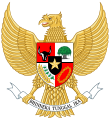Constitution of Indonesia
The constitution was written in June–August 1945, in the final months of the Japanese occupation of the Dutch East Indies at the end of World War II.
"[1] Following major upheavals in 1998 and the resignation of President Suharto, several political reforms were set in motion, via amendments to the Constitution, which resulted in changes to all branches of government as well as additional human rights provisions.
The territory then fell under the jurisdiction of the Japanese Southern Expeditionary Army Group (南方軍, Nanpō gun), based in Saigon, Vietnam.
On 1 March 1945, the 16th Army established the Investigating Committee for Preparatory Work for Independence (Indonesian: Badan Penyelidik Usaha Persiapan Kemerdekaan (BPUPK)), for Java.
It met in the building that had been used by the Dutch colonial quasi-parliament, the Volksraad ("People's Council") in central Jakarta.
[4] During the recess between the two BPUPK sessions, a Committee of Nine (Panitia Sembilan) comprising Sukarno, Hatta, Yamin, Maramis, Soebardjo, Wahid Hasjim, Muzakkir, Agus Salim and Abikoesno reformulated Sukarno's Pancasila in to a preamble for the future constitution.
The Japanese authorities, realising they would probably lose the war, began to make firm plans for Indonesian independence, more to spite the Dutch than anything else.
Sukarno and Hatta declared independence on 17 August 1945, and the PPKI met the following day.
The Committee made some fundamental changes, including the removal of 7 words from the text of Jakarta Charter which stated the obligation for Muslims to follow Sharia.
However, this state was short lived and when Indonesia became a unitary state in August 1950, the Working Committee of the KNIP became part of the House of Representatives and Constitution 1945 (usually referred to by the Indonesian acronym "UUD'45") remained in force until it was replaced by the Federal Constitution on 27 December 1949.
This was put to the vote on 30 May 1958 and 2 June 1959, but the motion failed to gain the required two-thirds majority.
Finally, on 5 July 1959 President Sukarno issued a decree dissolving the assembly and returning to the 1945 Constitution.
[14] Suharto, who officially became president in 1968, refused to countenance any changes to the Constitution despite the fact that even Sukarno had viewed it as a provisional document.
[15] In 1983, the People's Consultative Assembly (MPR) passed a decree stipulating the need for a nationwide referendum to be held before any amendments were made to the Constitution.
Then in 1997, the activist Sri Bintang Pamungkas and two colleagues were arrested and jailed for publishing a proposed modified version of the 1945 Constitution.
[16] With the fall of Suharto and the New Order regime in 1998, the 1983 decree and 1985 law were rescinded and the way was clear to amend the Constitution to make it more democratic.
The court was established in 2003 by 9 justices head by Professor Jimly Asshiddiqie ,a prominent scholar from the University of Indonesia.
The attached Elucidation, drawn up by Raden Soepomo (1903–1958), Indonesia's first justice minister, was officially declared to be a part of the Constitution on 5 July 1959.
[21] However, since the amendments, the Elucidation has not been updated, and still refers to the original document, including parts that have been removed, such as Chapter IV.
During the sessions in the People's Assembly, all the ideas set forth in the Elucidation was transformed become articles in the new amendments.
[24] Whereas Independence is the inalienable right of all nations; therefore, colonialism must be abolished in the world as it is not in conformity with humanity and justice.
Explains how Indonesia is divided into provinces, regencies and cities, each with its own administration chosen by general election.
Specifies the flag, official language, coat of arms, and national anthem of Indonesia.
Tasks the People's Consultative Assembly with re-examining decrees passed by it and its predecessors for their validity to be determined in the 2003 general session.

